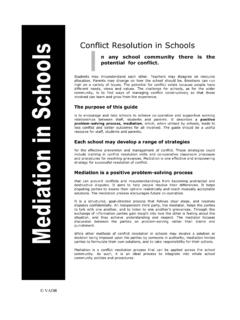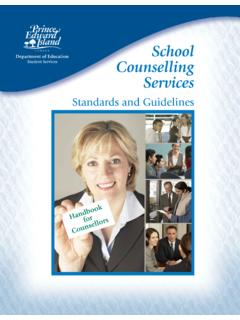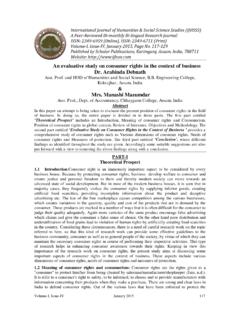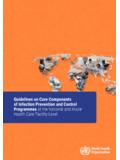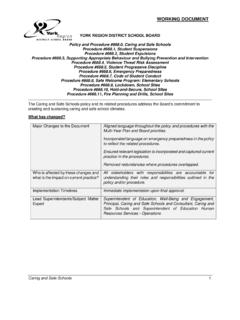Transcription of significant others - dovetail.org.au
1 05supporting the youth alcohol and drug sector in Queenslandworking with families and significant othersyouth alcohol and drug good practice guideDovetail provides clinical advice and professional support to workers, services and communities across Queensland who engage with young people affected by alcohol and other drug use. Dovetail is delivered by Queensland Health s Metro North Mental Health Alcohol and Drug Service. This guide was developed in partnership with the School of Public Health and Social Work at the Queensland University of Technology. Aimed at practitioners across clinical and community-based contexts, we trust these guides will further contribute to the growing knowledge and skill-base on how to effectively work with young people experiencing problematic alcohol and other drug with families and significant othersWritten by Phil Crane ( ), Tim Moore ( ), Maureen O Regan, Danielle Davidson, Cameron Francis and Cassandra by Benjamin Dougherty, Cameron Francis and Cassandra by Benjamin Dougherty.
2 About the authorsPhil Crane ( ) is Senior Lecturer in Youth Services at the School of Public Health and Social Work, Faculty of Health, Queensland University of Moore ( ) is Senior Research Fellow, Institute of Child Protection Studies, Australian Catholic University. Maureen O Regan is Social Worker / Family Counsellor with the Adolescent Drug & Alcohol Withdrawal Service, Mater Young Adult Health Centre, Davidson undertakes research and teaching with the School of Public Health and Social Work, Faculty of Health, Queensland University of Francis is Principal Consultant and Social Worker at Davis is Psychologist at Dovetail. Published byDovetailGPO Box 8161 Brisbane, Queensland, June 2016 ISSN: 0813-4332 ISBN: 978-0-9873015-4-3 Suggested citationCrane, P., Moore, T., O Regan, M.
3 , Davidson, D., Francis, C. and Davis, C. 2016. Youth alcohol and drug practice guide 5: Working with families and significant others . Brisbane. guide on working with families and significant others has many contributors. The development of specific material was iterative and developed over time through a range of processes and conversations. Thanks especially to: the services, practitioners and managers involved in the Dovetail network who contributed their examples, experiences and feedback the Bouverie Centre Family Institute, Family Drug Support and the Strong Bonds Project for permission to reproduce material the members of the Dovetail team, Cameron Francis, Cassandra Davis, Leigh Beresford and Benjamin Dougherty, for their extensive feedback, input and support the following participating organisations: Adolescent Drug and Alcohol Withdrawal Service (ADAWS); Alcohol, Tobacco and Other Drug Service (ATODS) Cherbourg, Mount Isa, Townsville; Bridges Health and Community Care; Brisbane Youth Service (BYS); Darumbal Community Youth Services; Lives Lived Well; Hot House Youth Allied Health Service.
4 IWC Bundaberg; Ted Noffs Queensland; Youth Empowered Toward Independence (YETI) and YFS for their input and initiative is funded by the Queensland and QUT make no representations about the suitability of this information for any purpose. It is provided as is without express or implied warranty. Dovetail and QUT disclaim all warranties with regard to this information, including all implied warranties of merchantability and fitness. In no event shall Dovetail or QUT be liable for any special, indirect or consequential damages or any damages whatsoever resulting from loss of use, data or profits, whether in an action of contract, negligence or other action, arising out of or in connection with the use or performance of this information. Links to external websitesThis guide contains links to other sites that are external to Dovetail and QUT.
5 We take care when linking to external web sites but we have no direct control over the content of the linked web sites, or to the changes that may occur to the content on those sites. It is the responsibility of the user to make their own decisions about the accuracy, currency, reliability and correctness of information contained in linked external 1 12 Family responsive practice with young people12 Defining family and significant others 13 Family responsive practice16 Family and attachmentSection 220 the family context of alcohol and other drug practice 21 How a young person s alcohol and other drug use can impact families22 Stages of change for families24 How a family s alcohol and other drug use can impact young people Section 326 Strategies for family responsive practice26 Family responsive engagement with young people28 Mapping the young person s relationships34 Mapping risk and protective factors relevant to family35 Static and dynamic factors36 Working with friends and peersSection 438
6 Working with young people and their families39 Engaging with parents and carers42 When family involvement is challenging44 Family meetings45 Mediation and conflict resolution46 Peer support for families49 Family therapy Section 554 Working with particular groups and populations54 Aboriginal and Torres Strait Islander young people and families55 Culturally and Linguistically Diverse (CALD) young people and families 57 Rainbow families59 Pregnancy and alcohol and other drug use60 Young parents61 Young carersSection 662 When there are concerns about safety or harm63 Queensland Child Protection legislation64 Young people leaving careSection 766 Developing a family friendly service66 Being a family friendly service68 The Family Responsive Youth Service (FRYS) Tool 76 ReferencesTables and Figures34 Table 1: Risk and protective factors in a young person s family49 Table 2: Family therapy models and theories14 Figure 1: Aspects of family responsive practice with young people23 Figure 2: Stages of change for families28 Figure 3: Basic genogram legend31 Figure 4: Genogram example - Darren s family33 Figure 5.
7 A time line approach35 Figure 6: Mapping static and dynamic family risk and protective factors 47 Figure 7: Stepping Stones Peer Support for Families10introductionWelcome to Dovetail s 5th Good Practice Guide, Working with families and significant others . This guide describes a family responsive practice approach to alcohol and other drug work with young people. Families can both impact and be impacted by a young person s use of substances. It is well known that family involvement in youth alcohol and other drug treatment can lead to more positive outcomes. This guide aims to outline a broad range of approaches and strategies that could be a part of a family responsive approach to working with young people, and to address some of the specific barriers to implementing this approach in is the 5th Good Practice Guide in the series.
8 It builds on the work of previous good practice guides, which you are encouraged to read. They are: 1. A framework for youth alcohol and other drug practice 2. Legal and ethical dimensions of practice3. Practice strategies and interventions4. Learning from each other: working with Aboriginal and Torres Strait Islander young peopleFocus and contents of this guide This guide is focused on supporting good practice by workers and services who work to minimise the harm from alcohol and other drug use experienced by young people, their families and their communities. Of course, not all alcohol and other drug use by young people is problematic. Problematic alcohol and other drug use refers to when the young person or those close to them consider that the young persons s alcohol and other drug use is having a negative effect on their physical, social and emotional health and wellbeing.
9 The guide provides information for workers in community and government services across a range of sectors, as well as workers specifically employed to work with young people around alcohol and other drug issues. Family responsive practice is a broad field, and this guide should be considered a selective summary rather than a comprehensive overview of approaches to working with families. Likewise, this guide has a narrow focus on services that engage with young people who are the primary client. 12 Section 1 Family responsive practice with young peopleConnections to family and significant others are critical to a young person s resilience. Even when relationships with parents or loved ones are conflicted, family remains important to a young person. A range of studies confirm that family of origin relationships remain important over time even if there has been abuse or physical separation (Dwyer & Miller 2006; MacLean et al 2009, Green et al.)
10 , 2013). In 2011, the Australian Institute of Family Studies reviewed family involvement in interventions for adolescent problem behaviours. In this paper they described family related protective factors such as, providing support, a secure base and a feeling of connectedness, that are linked to positive outcomes in adolescence and beyond (Robinson et al. 2011).For young people there is a protective effect in having at least one supportive relationship with an adult. An attachment relationship that is fostered between a young person and a supportive adult will provide an important protective factor against adversity. Ideally the adult will be a parent or other family member, but a warm relationship with a significant other adult is also protective in situations of adversity. Robinson 2006, working with young people could be one such supportive adult, recognising however that as their engagement is bounded and time limited, the larger purpose is to assist young people to develop their own networks of support.

